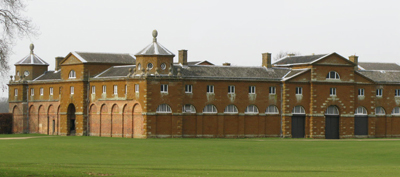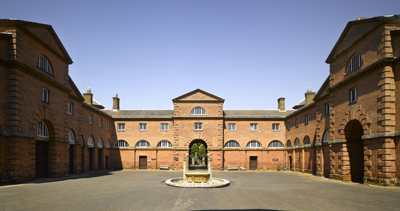Riding on Status: The Stables at Houghton by Giles Worsley
From the Country Life Archive: Sir Robert Walpole was a distinguished politician and a keen architectural patron, but when he was in the country he hunted six days a week. The stables he built at Houghton Hall, near King's Lynn, reflect his passions for hunting and architecture, but were also designed to impress the local gentry. Giles Worsley reports. Originally published in Country Life, September 27, 1990.


RETURN TO THE HOUGHTON REVISTED HOMEPAGE
Sir Robert Walpole knew how to keep his Norfolk supporters happy. Although they would have been impressed by his fashionable, new, great house, its expansive park, and its fabulous collection of paintings, the way to the heart of the 18th-century squire was through the horse. So Walpole hunted six days a week when he was in the country, had horses that any squire would give his eye teeth for, and built stables that were far grander than most of his guests' houses. His stables survive today, remarkably unaltered and still occupied by horses - a great rarity in these days of tea shops and stable conversions. Nowhere else can the feel of the 18th-century horse world be engagingly recalled.
The creation of Houghton was a deliberate political act. Walpole was no grandee with the guaranteed deference of a county to support his parliamentary pretensions. He had to work to secure his regional power base. Land meant status and so Walpole poured money into building up the state he had inherited from his father in 1700. By the time he died in 1757, he had quadrupled the rent role. He also laid out an enormous park and remodelled the house he had inherited, only to decide that it was still unsatisfactory and that it was better to demolish and build again. Work on the new house began in 1721, and the final cupola was completed in 1729, although the fitting up of the state apartments continued for some time afterwards.

Fig 1. The stables at Houghton Hall, Norfolk, from the north-east.
The house had something for everyone. For aesthetes the piano nobile provided sumptuous decoration and ravishing pictures, but the heart of the house was in the rustic below. As Lord Hervey rather sniffily reported to the Prince of Wales in 1731: "The base, or rustic story, is what is chiefly inhabited at the Congress ... the whole is dedicated to fox-hunters, hospitality, noise, dirt and business." These congresses were the key to Walpole's Norfolk influence. Every year as Prime Minister he would go down to Norfolk for a few weeks - in 1735 it was for three - and hold open house. Sir Thomas Robinson spent a week there in December 1731 and wrote back to the Earl of Carlisle that there were generally between 20 and 30 at table, with Walpole doing the honours extremely well, making it "perfectly agreeable" to all his guests. Entertainment on a lavish scale was the oil of Walpole's political machine.
It was not surprising that Hervey should write that the talk was of foxhunting. As Robinson reported: "They hunted six days in the week, three times with Lord Walpole's fox-hounds, and thrice with Sir R's harriers and indeed 'tis a very fine open country for sport." Doubtless they devoted the Sabbath to recalling the week's exploits.
Early-18th-century hunting called for fewer horses than foxhunting as it developed over the following century, when a keen sportsman hunting most days might need eight or 10 horses to keep him mounted. Nevertheless, to hunt six days a week Walpole would have needed several horses himself, and so would his huntsmen and guests. He needed stables large enough to house them. In the event he built them for 80 horses. Surprisingly, however, he built not one but two stables, of equal size, the first lasting only about 13 years.
Sign up for the Country Life Newsletter
Exquisite houses, the beauty of Nature, and how to get the most from your life, straight to your inbox.

Fig 2. Looking across the quadrangle. The fountain was added in the 20th century.
In 1731 Sir Thomas Robinson noted: "The stables (which are very large and have been finished about 13 years ago) are to be pulled down next summer, not only as they are very ill built, but stand in the way of one of the most agreeable prospects you have from the house." These stables appear in several plans, among them Colen Campbell's survey published in the third volume of Vitruvius Britannicus in 1725. They were in fact the first new structure to be built at Houghton, being begun in about 1719 and covered in November 1721.
Sadly, no view survives of these stables, but the plan shows them to have been designed as a regular quadrangle. At first sight this might seem unexceptional, as the Georgian stable quadrangle is such an accepted part of the country house, but it was the stables at Houghton that set the precedent.
There had been stables built as regular quadrangles before, but they were nearly all royal stables, such as Henry VIll's at Hampton Court, James I's at Theobalds or Charles II's at Lyndhurst, his New Forest hunting lodge. Before Houghton, large country houses might have an impressive stable range, but other elements of the yard, such as the barns and coach houses, would have been built individually. At Houghton all these various buildings were brought together in one unified whole, creating a building comparable in scale to the house itself, and worthy of dignified architectural treatment. The choice of a quadrangle was a practical one. It meant that all the different parts of the stable were easily accessible, that the stable activities could take place in a sheltered, secure yard and that the noise and smell were hidden from the house.
Frustratingly, we do not know who was responsible for this development, which was to prove so fundamental to the appearance of the country house. No architect is mentioned in connection with the first stables, and they are unlikely to have been the idea of Thomas Ripley, the unimaginative executant architect at Houghton. Is it the work of Colen Campbell, to whom the design of Houghton is generally given, or could it be that of James Gibbs, whom John Harris has suggested may have made the initial design for the house (COUNTRY LIFE, March 6, 1989)? Campbell seems the more plausible figure. Eighteenth-century architecture has numerous features that owe their precedent to him, while Gibbs, although a solid architect, was seldom an innovator.
Whoever the architect was, it soon became apparent that the stables were in the wrong place. Their position had been carefully chosen, for they closed the axis from the south front of the house and blocked out any view of the village street which ran behind the stables. But these advantages were removed when Walpole extended the park southwards, sweeping away the village. He now wanted to create a new approach to the house along an avenue from the south. The stables stood in the way. So they were demolished and rebuilt a few yards west behind the new avenue.
The basic plan of the new stable block followed that of its predecessor, forming a quadrangle with projecting blocks in the centre of each range. Work began in 1733 and continued to 1735. With Campbell dead, the architect was presumably William Kent, who was then fitting up the state rooms at Houghton. It would be interesting to compare the elevation of the earlier stables and to know how much was borrowed, but the design owes so much to Kent and Burlington's neo-Palladian style that it probably differs markedly.
In the centre of the two main fronts, those to the east and west, is a projecting gatehouse block with interlocking pediments derived ultimately from Palladios Venetian churches (Fig 1). On either side are five bays of blank arcading with Diocletian windows in the arches to light the stables behind. Kent had developed this classic 18th-century stable elevation at the Royal Mews a couple of years earlier in 1731-33 (COUNTRY LIFE, November 12, 1987). Finally, the corners were marked by a slightly projecting quoined bay, capped by an octagonal cupola set about with balls on plinths, a characteristic feature of Kent's staccato style. The north and south fronts are identical except that the gatehouse blocks are only one rather than three bays wide, and the flanking ranges are of four rather than five bays.
To the visitor passing under the entrance arch, the 18th-century sense of propriety in the use of materials is soon evident. The exterior of the stable is built of local Snettisham stone, yellower and coarser than the fine, pale Whitby stone used on the house, and therefore distinguishing the building, for all its grandeur, as inferior to the house. The internal walls of the quadrangle, by contrast, are built of cheaper brick, but with a touch of variety being added by the cornice, which is again in Snettisham stone.
Like all country-house stables, those at Houghton have been altered, principally when loose boxes were added in the 19th century. There have also been some minor structural alterations, such as doors blocked up or openings made in walls. But whereas in many stables all the original fittings were replaced in the 19th century, at Houghton many survive. The most important are the stalls in the north-east range, but also of interest are the heavy horse standings in the south-west corner. The stalls are exceptional in their quality. It remained the custom at Houghton, into the 1930s, for the gentlemen to examine their horses on the way to church every Sunday. Walpole would undoubtedly have done the same in the 18th century, and these grand stalls were designed to show off his fine horses and reflect his prestige. Brick vaulting gave an architectural distinction to the interior, which was then continued by the Doric columns surmounted by balls behind every second stall. The racks - with their twisting uprights to allow the horses to pull the hay through easily - and mangers survive unaltered. So also do pegs for the bridles set into the walls behind, above the feed bins, which double as benches for the grooms. The saddles would have been kept in the adjoining saddle room.
These were for Walpole's finest hunters, each of which had its own stall. In the south-west corner two different types of stabling survive. One range, which was probably for coach horses, has room for six horses, but partitions only between every other horse. Hanging bars or bales would have separated each pair of horses. These have disappeared, but the hooks survive. Although cheaper stalls than those for the hunters, the racks and manger follow the same design. Next door was stabling that must have been for cart horses, with a sloping rack and no partitions. This was the cheapest form of stabling.
Today, the stables at Houghton are still in use and open to the public, who now take the place of the Norfolk gentry in admiring Sir Robert's creation.
Photographs: 1 by John Goodall; 2 by Will Pryce. If you are interested in additional images of this property, please contact the Country Life Picture Library.
RETURN TO THE HOUGHTON REVISTED HOMEPAGE
HOUGHTON HALL: AUGMENTING A MASTERPIECE BY MARCUS BINNEY (FREE PDF DOWNLOAD)
HOUGHTON HALL WALLED GARDEN: THE QUEST FOR NEW IDEAS BY TIM LONGVILLE (FREE PDF DOWNLOAD)
WHO DESIGNED HOUGHTON? BY JOHN HARRIS
HOUGHTON HALL, NORFOLK - I: THE SEAT OF THE MARQUESS OF CHOLMONDELEY BY JOHN CORNFORTH
HOUGHTON HALL, NORFOLK - II: THE SEAT OF THE MARQUESS OF CHOLMONDELEY BY JOHN CORNFORTH
Agnes has worked for Country Life in various guises — across print, digital and specialist editorial projects — before finally finding her spiritual home on the Features Desk. A graduate of Central St. Martins College of Art & Design she has worked on luxury titles including GQ and Wallpaper* and has written for Condé Nast Contract Publishing, Horse & Hound, Esquire and The Independent on Sunday. She is currently writing a book about dogs, due to be published by Rizzoli New York in September 2025.
-
 Some of the finest landscapes in the North of England with a 12-bedroom home attached
Some of the finest landscapes in the North of England with a 12-bedroom home attachedUpper House in Derbyshire shows why the Kinder landscape was worth fighting for.
By James Fisher
-
 The Great Gatsby, pugs and the Mitford sisters: Country Life Quiz of the Day, April 16, 2025
The Great Gatsby, pugs and the Mitford sisters: Country Life Quiz of the Day, April 16, 2025Wednesday's quiz tests your knowledge on literature, National Parks and weird body parts.
By Rosie Paterson